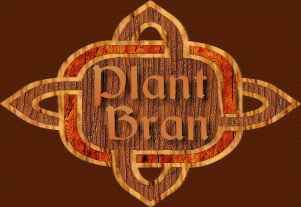
Celebrating the Festivals
by Gwenfran Gwernan
![]()
Nearly all religions celebrate festivals throughout the year. These are memorials to happenings in the legends of the Gods, agricultural and agrarian magics and festivals of the natural year; often sympathetic magics to assist the seasonal changes and happenings, the journey of the Sun, or the fertility of man and beast.
The festivals at the Solstices and Equinoxes follow the rise and fall of the Sun's life, following His birth, growth, wooing, dying and rebirth.
We in the Plant Bran try to celebrate the seasons bringing in as much of the Old Ways as possible within the confines of modern living. Those things which we cannot do are remembered and passed on. Many of the traditional festivities were country based, and unless one lives on a farm or smallholding, some of the things just cannot be performed except in ritualised form.
In the Craft in general, the festival of Samhain puts the emphasis on the dead, but in the Plant Bran it is rather different. It is the most important of our Festivals; it is the time of The Great Assembly of all those who 'were, are, or will be' members of the House or Family. All are asked to attend the gathering, and we listen in silence to anything which they have to communicate to us; afterwards discussing these 'messages' together with any other matters affecting the running of the Family. Adoptions of new members take place at this time and this involves a re-birth ceremony, which is the only form of 'initiation' that we have. There are no degrees.
Yule, of course, celebrates the rebirth of the Sun (Son); the time when He starts his climb back towards the Northern Hemisphere to give us more light and warmth, and with it, Spring and Summer. We see Him symbolically born from the cauldron with a fanfare and the lighting of candles, and we pass round a bunch of mistletoe for the traditional kissing beneath it.
We 'Hunt the Wren' a few days later, (symbolically, of course!), to signify the death of the old (Solar) year and the beginning of the new. The Robin on the Yule cards signifies the 'new' year, whilst the Wren, the old; and have you noticed that the Wren is becoming more featured on cards these days?
For every day following His birth at the Solstice, the young Sun ages a year, so by Twelfth Night he is old enough, by Celtic tradition, to be 'armed' by his mother, in a ceremony following which he is sent out into the world to 'adventure mightily'. Fire arrows are fired, either actually or symbolically, depending on the weather!
Imbolc is the Festival of Women, where we celebrate the mystery of how the Lady, who has at Midwinter given birth to the young Sun, is although a Mother, still a Maiden. The Women's Mysteries are closed to the men, who retire at that point in the celebrations. We call Brede, springtime Goddess, into our homes and prepare a bed for Her, as was done of old.
The Vernal Equinox has the great feeling of welcoming back the Goddess as Giver of all life, for already there are many flowers and green shoots appearing, birds have begun to nest, and lambs can be seen frolicking in the fields, watched over by the anxious dams. It may be possible for some people to perform a plough blessing ceremony if circumstances permit, but if it isn't then a symbolic ploughing and sowing of seeds is performed, with a magical wish that both our physical and mental needs will be met during the coming year. To us, this is the time when the Young Lord meets His Lady Mother, and couples with her, so we perform a lively dance to signify the courtship and winning of the Lady.
At Beltane the Lord again pursues the Lady, as a white doe in the forest, who, after evading capture with the help of the trees, reveals Herself as the Lady He met at the Equinox. He then takes on the responsibility of the family, and they are wed, jumping the broomstick in traditional fashion. The ritual wouldn't be complete without a Maypole dance or two, and the dancing between the two Beltane fires is a 'must'. You don't have to be fit for this ritual, but it does help!
The Summer Solstice follows, with its emphasis on the fact that the Sun has reached the peak of His power; he is on the 'topmost peak of heaven's hill'; but the only way now is into decline, and we in the Northern hemisphere have to acknowledge the fact that the fall to Winter has begun. This we symbolise by lighting a fire wheel bearing a sprig of oak and rolling it down a slope.
Lughnasadh follows - the mourning for Lugh. The first grain crop, barley, is beginning to be harvested, and this is celebrated by a spirited rendering of sixteen verses of John Barleycorn! Now the God's main reproductive functions are really beginning to decline to old age, awaiting death and rebirth at Yule. In our rite we cut the ripe barley to signify this.
The traditional Harvest Festival is the theme of the Autumn Equinox celebrations. It marks the end of the grain, nut and fruit harvest, and the making of all things ready for Winter. The Lord and Lady are thanked for the food that has been safely stored away. It is the time when preparations are made for stalling the cattle and preparing winter quarters for other animals for the cold dark times to come. Not so important for town dweller to 'do', but farmers have to do it for us, so we acknowledge this fact.
We remember too that between now and Samhain was the time for culling all but the main breeding stocks of animals in a time when animal fodder was not so easy to gain and store, and salt the meat down for Winter use. Samhain was the 'Third Harvest' - that of the animals.
In all our rituals and celebrations, traditional song and dance play a large part, and fun as well as reverence is the order of the day. Seasonal decorations of fresh flowers etc. decorate our shrine and places of working, together with branches, leaves or fruit of the tree associated with the month.
![]()
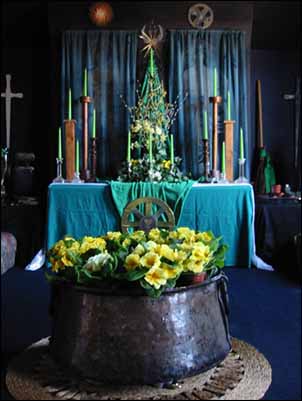
Shrine at Spring
![]()
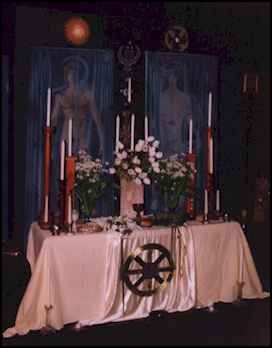
Shrine at Beltane
![]()
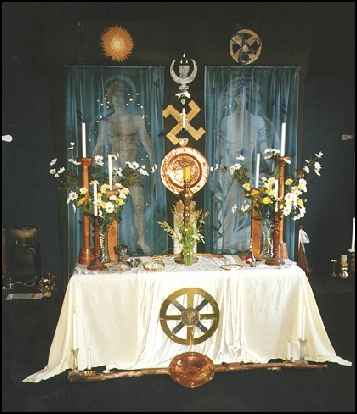
Shrine at Midsummer
![]()
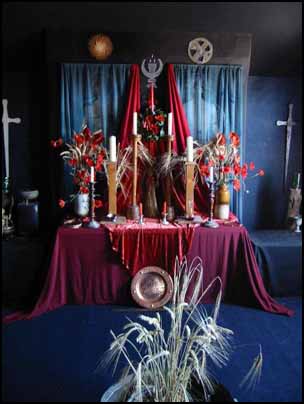
Shrine at Lughnasadh
![]()
Shrine at Samhain
![]()
Shrine at Yule
![]()


